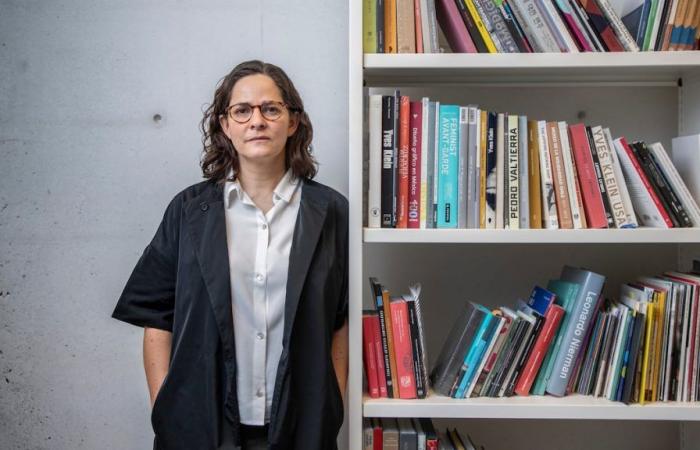It is the middle of a cloudy morning in Mexico City and the first visitors are already strolling through the rooms of the University Museum of Contemporary Art (MUAC). The majority are young, they wear spring clothes even though the sky threatens to unleash one of those storms typical of the rainy season in this capital of uncontrolled weather, and they walk as if they have already visited these rooms dozens of times and know them perfectly. the corners of one of the most important Contemporary Art collections in Mexico and Latin America. They pass very close to Tatiana Cuevas (Mexico City, 49 years old), who poses smiling for the photographer’s camera, minutes after a talk with this newspaper in which she stressed that she takes the reins of the MUAC with two very fixed ideas: continuity in the strategy of a museum that has completed 15 years, attentive to the trends that mark the pace in art and with the interest of attracting youth at times when social networks and technological devices capture their attention. “We want them to relate to reality beyond the screens again, to exercise that ability to observe a work,” she says.
Cuevas has been at the helm of the MUAC for just six weeks and is in the middle of the transition process. The museum already has an established program for the remainder of the year and the new director is satisfied with that, because, she says, some of the exhibitions she would have liked to propose. “It is a museum that has its mission and scope so clear that the first assurance I had was that there is not much more to do, we have to continue. And that also gave me enormous peace of mind, because normally when you take a position of this type you tend to think that you have to change things, but something that I have learned in my career is that the best thing you can do is continue and improve.” explains Cuevas, an art historian from the Universidad Iberoamericana and with a specialty as a curator of contemporary art at the Royal College of Art in London. She has worked at the National Gallery of British Art and Modern Art; the Lima Art Museum, in Peru; and the Tamayo Museum and Carrillo Gil Art Museum, in Mexico City. Cuevas replaces Amanda de la Garza as head of the MUAC, appointed deputy artistic director of the prestigious Reina Sofía Museum in Madrid.
The new director also has a team with extensive experience, always willing to do their best to ensure that each exhibition is a success. And the curatorship of this museum makes visiting the exhibitions pleasant, as is currently the case with that of the Colombian Beatriz González, titled War and peace: a poetics of gesture, who with his art presents the tear of violence, the hope of peace and the importance of memory. Cuevas says that this is what he wants to promote in the museum: for it to become a space for reflection. And a place where young people can meet to discuss topics that provoke them.
40% of the museum’s visitors, says Cuevas, are precisely young people, because the MUAC has the advantage of being part of the National Autonomous University of Mexico (UNAM), but she wants to expand those borders. “Museums are often considered an alternative apart from all other recreational possibilities. The MUAC is one of the museums where young people approach almost naturally, they come and see the exhibitions and are also at book presentations, but without a doubt we have to bring them closer, and that without leaving the balance or contrast that it has managed. always the museum’s programming: between historiographical reviews, others that are more documentary, practices that are much more seductive in visual terms and others that are more seductive in academic terms, but also being more sensitive to new possibilities of artistic creation. Great trajectories are not the only ones we should present,” says the director.
To reach a new generation of spectators, Cuevas has thought of two strategies: bringing art to schools, high schools and high schools and reaching out to young artists, who may feel that the large art venues turn their backs on them. “It is a generation that is at that moment in which it can discover many things, whether through art, simply out of the interest of approaching and finding new ways of seeing the world, but also as a task, as a reflection, as a possibility” , Explain. The director has thought about resuming the project The MUAC in your home, which the museum developed with a community in the south of Mexico City. The venue gave a work to a family and its members were in charge of taking care of it and sharing it with the neighbors. “We want to take it to the schools now and have the students take charge of all this management. We also want to bring them closer to the work of a museum by doing it themselves, mediating the piece with their colleagues. Hold workshops, conversations, topics that arise from our works to enrich the concerns that the children have. What every museum looks for is not a one-time visitor, but a recurring visitor, who is here several times a year,” Cuevas emphasizes.
Cuevas has been sensitively concerned about a recent study on the consumption of information in digital media by the Reuters Institute, which reveals that traditional media are being displaced by social networks, especially by TikTok, a video application to which every More and more young people come to get informed, with the risks that this can imply in a virtual world where hoaxes and false information abound. That is to say, we are facing a generation that is increasingly glued to the screen. Cuevas dedicates part of her working hours to understanding what she calls this “vortex of digital information consumption” and social networks to make audiences “relate to reality.” She understands the importance of networks—in fact the museum uses them to attract visitors—but she would also like people to find a moment to disconnect at the MUAC. “I believe in the exercise of stopping before a piece of video, pictorial, sculptural, but stopping, not consuming and browsing, being able to exercise again that ability to observe and decipher what this image is telling me and not digest it as you have it on all the other platforms,” says Cuevas.
The other strategy, focused on the new generation of artists, involves dedicating a room to expose these new filmmakers, helping them develop their artistic projects with the support of the museum team. And Cuevas says that he sees contemporary art in Mexico “with a richness and an energy that I believe is even unfathomable,” but that he continues to need the support of prestigious institutions such as the MUAC so that these new proposals can be visualized. “The collaboration of the younger generations of artists is a mechanism of recognition of what each of them is doing,” she acknowledges. The director warns, however, that these are not quotas, as was once thought to open greater spaces to female artists and artists from the LGBTI community. “Yes, obviously the fight for greater equality, greater balance will continue, but no longer based on the community that needs to be made visible. I think it’s more about the proposals, that your proposal is relevant. At some point it was very wrong to talk about quotas that we have to cover, although what should guide us is an awareness of not putting our hand on one side or the other,” she argues.
Cuevas affirms that she feels “excited” about the new challenge of taking the reins of the MUAC and all the cultural projects that revolve around the museum. She sees it, she says, as recognition of her career. “When they called me to be part of the shortlist, I felt absolute emotion, saying that all the work I have done has been worth it, it has been seen. When they asked me to prepare a preliminary project to see what I would do with this museum, I sat down to work on it and suddenly said ‘yes, I know what to do’. I think that if this opportunity had come to me sooner, I don’t know if I would have been able to respond so easily, and certainly the Carrillo Gil experience was like a turning point for me in understanding myself from another perspective, not only curatorially, but being able to manage, lead and build on a larger scale,” acknowledges the new director of the MUAC.
Sign up for the EL PAÍS México newsletter for free and to whatsapp channel and receive all the key information on current events in this country.






